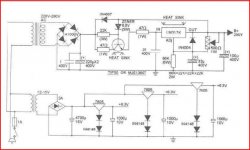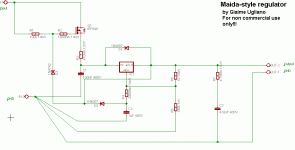Hi, it probably will work but it is playing with fire. The dangerous moment is when switching it on. Because of the quite large cap at the output it could be that the voltage over the 317 exceeds the max. values by a large margin. Maybe TL783 is a better choice.
I remember Elektor using a 400 V max. rated reg but unfortunately I don't remember the typenumber. That one was also a 3 pin reg.
I found a few regs using parts that are rated for such high voltages.
http://www.linearaudio.nl/t-reg-2.htm
I remember Elektor using a 400 V max. rated reg but unfortunately I don't remember the typenumber. That one was also a 3 pin reg.
I found a few regs using parts that are rated for such high voltages.
http://www.linearaudio.nl/t-reg-2.htm
Last edited:
Hi, it probably will work but it is playing with fire. The dangerous moment is when switching it on. Because of the quite large cap at the output it could be that the voltage over the 317 exceeds the max. values by a large margin. Maybe TL783 is a better choice.
I remember Elektor using a 400 V max. rated reg but unfortunately I don't remember the typenumber. That one was also a 3 pin reg.
I found a few regs using parts that are rated for such high voltages.
http://www.linearaudio.nl/t-reg-2.htm
I will have a look thank's for your interest
Do a search for Linear brief 47, by Michael Maida. Very easy circuit to build and can easily be built with your size requirements. Very similar to the circuit you posted, just less complicated and more stable. You could also use the regulator from Sy's Red Light District amplifier.
Better the Mosfet Maida, and a try with IRF820 may prove better in the highs.
Attachments
Will the Maida circuit drop 400V to 250V?
Thought you might know the most you can drop across it?
If you design it correctly and you provide an adequate heatsink.
I wouldn't try to drop any more power than you can safely dissipate with your heatsink or drop more voltage than your pass transistor can handle without breaking down. Other than that, you can dissipate 10000V if you can find adequate parts.
Last edited:
Hello All,Hi,
Has anyone used this regulator? I am refering to the HT side!
I am thinking of using a LM317T device in place of the LM317K because of low current requirements!
Does anyone see any problems with this?
Thank's for any input!
Regards
M. Gregg
Joe Curcio the Dynaco Doctor and echoed by Morgan Jones did that or very similar years ago as a master regulator and then used an Op-Amp slave regulator at individual tubes .Joe wrote a paper about the sound of the power supply.
National Semiconductor also had that application in a application note back when. I saw Joe's name on a National AN for 4562 Op-Amps a couple of years ago.
I built a couple and they worked fine, as in no smoke.
DT
All just for fun!
With THAT much voltage drop you could use a valve rather than a transistor!Will the Maida circuit drop 400V to 250V?
Thought you might know the most you can drop across it?
Extra heater supply needed, admittedly. But at least the heat sink requirements would be minimal.
The reg you show IS a Maida regulator. Very reliable, works well. Not the very best as far as noise, but for applications where the signal circuit has reasonable supply rejection and/or line-level or higher signal, it's more than good enough. I wouldn't use it, for example, to supply a cascode phono input stage, but I use them pretty much anywhere else.
If you need to drop a lot of volts, put a resistor in series with the input to absorb some of the excess power.
If you need to drop a lot of volts, put a resistor in series with the input to absorb some of the excess power.
Hi, it probably will work but it is playing with fire. The dangerous moment is when switching it on. Because of the quite large cap at the output it could be that the voltage over the 317 exceeds the max. values by a large margin.
No, that's the function of the Zener to the pass transistor's base- it guarantees that the drop across the regulator remains within the Zener voltage plus one Vbe- the pass transistor (which should be a high voltage unit or a MOSFET) is the device which sees the HV at switch-on.
The reg you show IS a Maida regulator. Very reliable, works well. Not the very best as far as noise, but for applications where the signal circuit has reasonable supply rejection and/or line-level or higher signal, it's more than good enough. I wouldn't use it, for example, to supply a cascode phono input stage, but I use them pretty much anywhere else.
If you need to drop a lot of volts, put a resistor in series with the input to absorb some of the excess power.
SY,
Thank's for the information. Any thoughts on using the LM317T in place of the LM317K? I assume this is just a current issue!
Regards
M. Gregg
Last edited:
Sorry, I can't remember which is the TO3 and which is the TO220. 
In any case, I've used both interchangeably, depending on what I have on hand, but never actually found a need for the TO3 device in tube circuits- the voltage drop across it is something like 15V, so even at pretty hard use (say, the 200mA of stereo 6L6 or EL34 output stages), we're talking about 2-3 watts, which is well within the TO220 device's limits (use a heat sink!). The pass transistor is the critical bit for higher power operation; a MOSFET or Darlington can be a better choice as the currents go up, because of base current issues.
In any case, I've used both interchangeably, depending on what I have on hand, but never actually found a need for the TO3 device in tube circuits- the voltage drop across it is something like 15V, so even at pretty hard use (say, the 200mA of stereo 6L6 or EL34 output stages), we're talking about 2-3 watts, which is well within the TO220 device's limits (use a heat sink!). The pass transistor is the critical bit for higher power operation; a MOSFET or Darlington can be a better choice as the currents go up, because of base current issues.
Sorry, I can't remember which is the TO3 and which is the TO220.
In any case, I've used both interchangeably, depending on what I have on hand, but never actually found a need for the TO3 device in tube circuits- the voltage drop across it is something like 15V, so even at pretty hard use (say, the 200mA of stereo 6L6 or EL34 output stages), we're talking about 2-3 watts, which is well within the TO220 device's limits (use a heat sink!). The pass transistor is the critical bit for higher power operation; a MOSFET or Darlington can be a better choice as the currents go up, because of base current issues.
Thank' again,
The TO3 is the LM317K.
This will be driving an Aikido line stage! No phono section so very low current.
Regards
M. Gregg
Last edited:
The reg you show IS a Maida regulator. Very reliable, works well. Not the very best as far as noise, but for applications where the signal circuit has reasonable supply rejection and/or line-level or higher signal, it's more than good enough. I wouldn't use it, for example, to supply a cascode phono input stage, but I use them pretty much anywhere else.
If you need to drop a lot of volts, put a resistor in series with the input to absorb some of the excess power.
I have had very good luck using Maida regulators and snubbing(RC) the transformer secondary. The Maidas are very effective at calming the 120Hz ripple but much less so at attenuating higher frequency SS diode switching transients. Instead of trying to design some super-regulator I just nip em in the bud. I don't have any sophisticated noise-measuring equipment but noise is unmeasurable on my scope at that point. I used to be able to see little tiny sharp jagged things at a rate of 120Hz before I started doing this.
Sy, is the noise you are talking about random noise or high frequency stuff that the Maida is less effective at calming?
Hello M Gregg and All,
If you are supplying a Aikido consider using John Broskie’s PS-1 regulator. PS-1 Solid-State Regulator Kit
Over several iterations of power supplies in The Audio Amateur Walt Jung and others pointed out the issue of noise with the LM 317. Yes it was noise increasing with each octave of frequency.
DT
All just for fun!
If you are supplying a Aikido consider using John Broskie’s PS-1 regulator. PS-1 Solid-State Regulator Kit
Over several iterations of power supplies in The Audio Amateur Walt Jung and others pointed out the issue of noise with the LM 317. Yes it was noise increasing with each octave of frequency.
DT
All just for fun!
Hello M Gregg and All,
If you are supplying a Aikido consider using John Broskie’s PS-1 regulator. PS-1 Solid-State Regulator Kit
Over several iterations of power supplies in The Audio Amateur Walt Jung and others pointed out the issue of noise with the LM 317. Yes it was noise increasing with each octave of frequency.
DT
All just for fun!
DT,
Was this with high gain circuits such as "Phono" or with line stage as well?
Regards
M. Gregg
- Status
- This old topic is closed. If you want to reopen this topic, contact a moderator using the "Report Post" button.
- Home
- Amplifiers
- Tubes / Valves
- Has anyone used this regulator?

